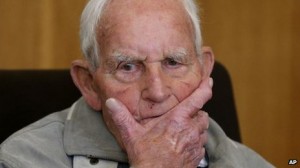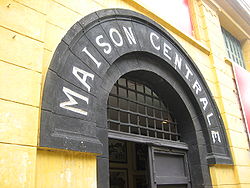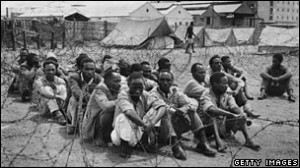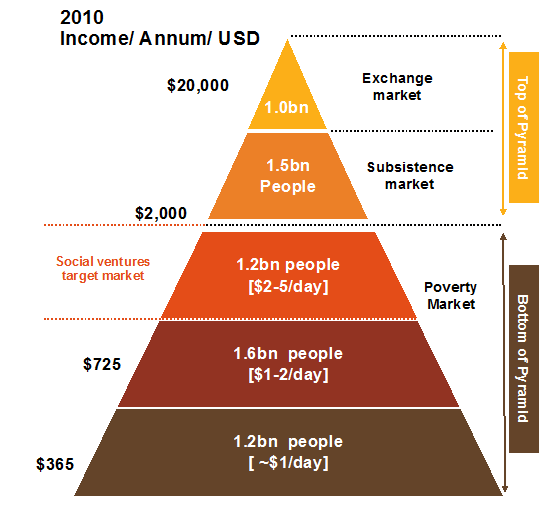Another Nazi trial began just a couple of months ago in the Netherlands. While people such Siert Bruins, the man on trial, should be tried and, if found guilty, punished for their crimes, it made me think that while so much time, energy and media space is devoted to the cases of former Nazis and their crimes, no one talks about the crimes committed by the colonial powers in their colonies in roughly the same time period as the Nazis, or the need for punishing the guilty in such cases, or at a minimum, receiving an apology for the heinous crimes that were committed.

Siert Bruins, a former Nazi on trial in the Netherlands
Consider for instance the Jalianwala Bagh massacre in 1919. British Army General Dyer ordered 150 British troops to open fire without warning on peaceful celebrators on the occasion of the Punjabi New Year on April 13, 1919. According to colonial British Raj sources there were 379 fatalities and about 1100 wounded. Civil Surgeon Dr. Smith indicated that there were 1,526 casualties. The true figures of fatalities are unknown, but are likely to be many times higher than the official figure of 379.
According to historian and British Army officer Horace Swanson, “At six minutes to sunset they opened fire on a crowd of about 20,000 people without giving any warning. Towards the exits on either flank, the crowds converged in their frantic effort to get away, jostling, clambering, elbowing and trampling over each other. Seeing this movement, Brigs drew Dyer’s attention to it, and Dyer mistakenly imagining that these sections of the crowd were getting ready to rush him, directed the fire of the troops straight at them. The result was horrifying. Men screamed and went down, to be trampled by those coming after. Some were hit again and again. In places the dead and wounded lay in heaps; men would go down wounded, to find themselves immediately buried beneath a dozen others.

Entrance to Jalianwala Bagh
The firing still went on. Hundreds abandoning all hope of getting away through the exits, tried the walls which in places were five feet high and at others seven or ten. Fighting for a position, they ran at them, clutching at the smooth surfaces, trying frantically to get a hold. Some people almost reached the top to be pulled down by those fighting behind them. Some more agile than the rest, succeeded in getting away, but many more were shot as they clambered up.
20,000 people were caught beneath the hail of bullets: all of them frantically trying to escape from the quiet meeting place which had suddenly become a screaming hell. Some of those who endured it gave their guess as a quarter of an hour. Dyer thought probably 10 minutes; but from the number of rounds fired it may not have been longer than six. In that time an estimated 1000 people were killed, and 1,500 men and boys wounded. The whole Bagh was filled with the sound of sobbing and moaning and the voices of people calling for help.”
General Dyer was never punished. Indeed the then Lieutenant Governor of Punjab, Michael O’Dwyer had a telegram sent to General Dyer saying ” “Your action is correct and the Lieutenant Governor approves.” Dyer died a natural death in Britain in 1927 after being exonerated by a commission. The British government to date has not apologized for this horrific official action by the British Army at Jalianwala Bagh.
Or consider the Hoả Lò Prison in Vietnam. The prison was built in Hanoi by the French, with a capacity to hold 460 prisoners, at the tail end of the 1800s, when Vietnam was still part of French Indochina. The French called the prison Maison Centrale, a traditional euphemism to denote prisons in France. It was intended to hold Vietnamese prisoners, particularly political prisoners agitating for independence, who were often subject to torture and execution. The prison was grossly overcrowded and toward the end of France’s occupation of Vietnam, held over 2000 people; with its inmates held in subhuman conditions. No one has been tried or punished for the inhuman treatment of the Vietnamese, which occurred a full decade after the end of the Nazi era, by the French colonial administration.

Hoả Lò Prison in Hanoi
Or consider the suppression of the Mau Mau by the British in Kenya, which occurred in the post WW II era. The BBC quotes Solicitor Martyn Day as saying “They were put in camps where they were subject to severe torture, malnutrition, beatings. The women were sexually assaulted. Two of the men were castrated. The most severe gruesome torture you could imagine.”

Thousands of Mau Mau suspects were detained in prison camps
“A lot of the officers involved were white, they were controlling the violence against these Mau Mau. It wasn’t just isolated individual officers. It was systematic. The whole purpose was to break the Mau Mau.”
The BBC goes on to report that “The UK says the claim is not valid because of the amount of time since the abuses were alleged to have happened, and that any liability rested with the Kenyan authorities after independence in 1963.”
I wonder at this asymmetry. Why are the atrocities committed by individual Nazis during the Second World War worthy of so much greater attention than these other atrocities? True the Holocaust is particularly heinous not only in modern history, but in history per se, but the individual actors, aside from the architects of that atrocity, generally had no more blood on their hands than the likes of General Dyer or the French adminstrators of Hao Lo Prison.
The answer I think lies in the fact that the Nazi trials are about the death of white Europeans; not brown, yellow, or black people. Why do I say this? One only has to look at the pronouncements of the colonial powers to see this mindset. For instance, the Portuguese government in Lisbon, the overseas empire was a matter of national interest, to be preserved at all costs. And, a Portuguese delegate to the International Labour Conference in Geneva in 1919, less than 100 years ago, is reported to have said: “The assimilation of the so-called inferior races, by cross-breeding, by means of the Christian religion, by the mixing of the most widely divergent elements; freedom of access to the highest offices of state, even in Europe – these are the principles which have always guided Portuguese colonisation in Asia, in Africa, in the Pacific, and previously in America.” (Humbaraci, Arslan and Muchnik, Nicole (1974), Portugal’s African Wars, New York: Joseph Okpaku Publishing Company, p. 99-100). Clearly, non-white citizens of the colonies were seen as inferior, in need of cross-breeding like cattle to raise them to an equal status with their European masters by the Portuguese! One hears the echoes of same racism in the works of celebrated British author and Nobel Laureate in literature, Rudyard Kipling. He portrayed Indian characters and other colonized people as being incapable of surviving without the help of Europeans. His works refer to “lesser breeds without the Law” in “Recessional” and “half-devil and half-child” in the poem “The White Man’s Burden”.
These racist views have not changed. They have merely been suppressed due to their perceived political incorrectness in today’s day and age. One only has to look at the frequent instances of abuse hurled at non-white players during European football matches, or the treatment of North Africans in France, or…, to see that this view still lives on, albeit mainly under the surface on in peoples’ unconscious minds. This is why, I am suggesting that former Nazis are aggressively pursued for their crimes, but the crimes committed by European colonists are swept under the rug!








